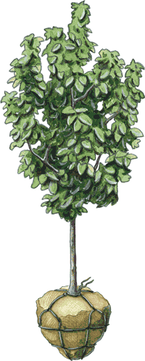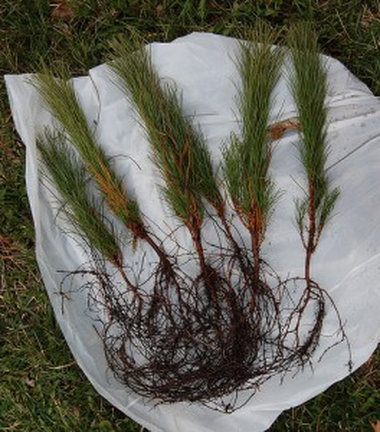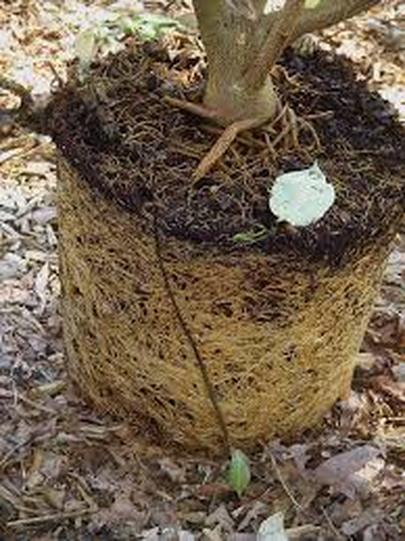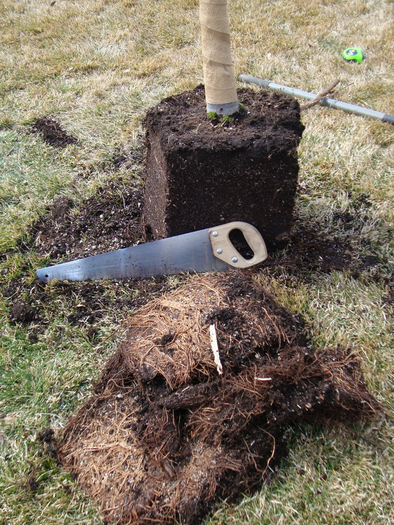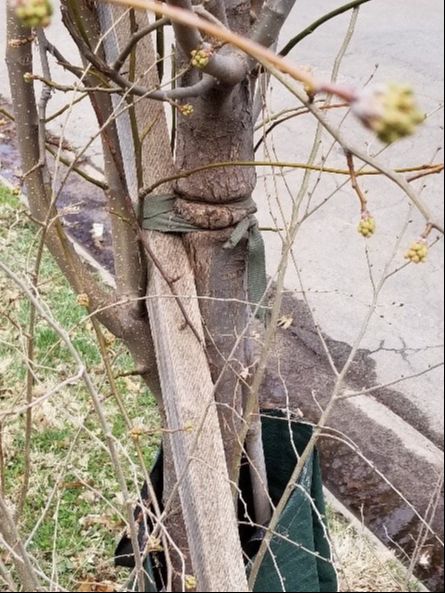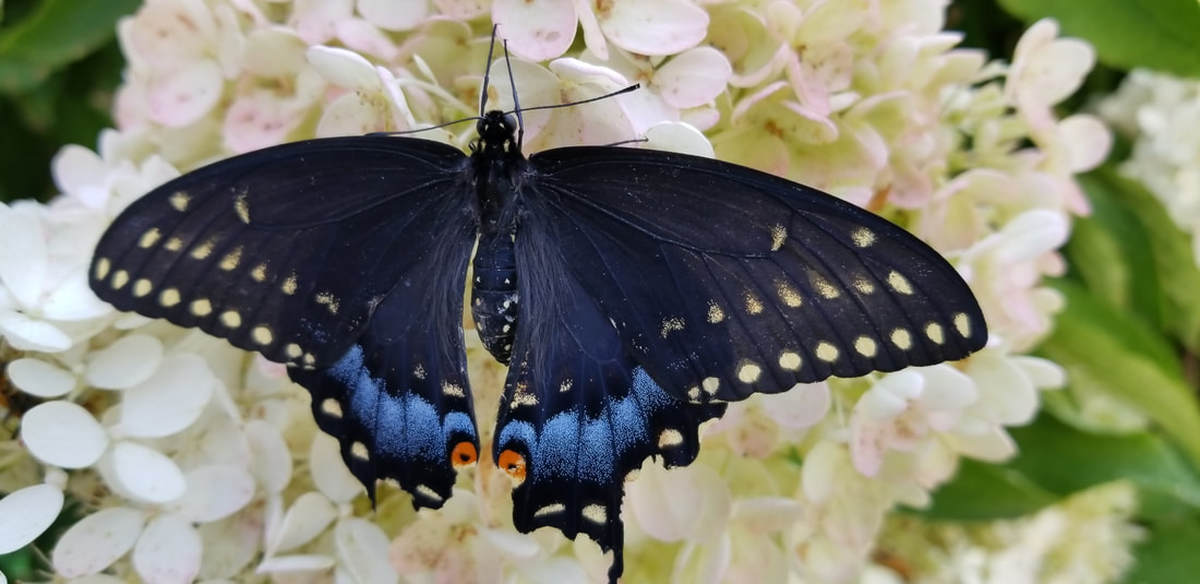Correct methods of tree planting!
Authored by Tristan mahler
|
Introduction: There many misconceptions about planting trees. “Newly planted trees need to be staked or guy-wired” (1), the second myth is “when planting a tree, the hole must be dug 2-3 times the depth of the root ball to ensure the roots have room “. Neither of these myths are true. For example, ball and burlap trees are very bottom heavy and can stand on their (2). But in reality, it’s not staking the trees that kills them it’s the improper stewardship. The problem with staking is that when leaving canvas or wire on the tree too long, is that as the tree grows and puts on new wood. The wire begins to get tighter and tighter slowly strangling the tree. The strangling is because the tree is putting on new wood slowly expanding outwardly.
The same concept applies when you plant a tree too deep. Improper planting depth promotes irregular growth from the trunk. This irregular growth causes girdling roots to form( see figure 1). This will eventually kill the tree via strangling just like old canvas or wires left on the tree. The best planting depth is to plant at the first primary lateral root or slightly above the soil line. (the first primary lateral root, is the first dominant root extending horizontally from the tree's main trunk). Both of these myths are still a problem today as many nurseries still practice staking there planting stock which greatly increases the chance for stakes being need at later planting in the consumers location (1). Below, I will also talk about tree planting fundamentals, several different types of containers (balled and burlap, containerized, and bare root) (2) |
First, Planting stocks
Balled and bur-LappBalled and bur-lapped trees (sometimes referred to as B&B) consist of the tree roots dug out of the soil in a ball. then it is wrapped in burlap and string or wire to hold the ball together.
Advantages of B&B
|
container grown treescontainer grown trees are just like they sound grown in a nursery container. These come in many different shapes and sizes. and There are many different types of containers these can be air pruning pots, solid walled or even fabric based.
Advantages of container grown trees
figure 3 Above contains three different potting container types.(8)
|
bare root
Bare roots stock is as simple as it sounds. A tree with bare roots, no soil on the tree yet.
Advantages of bare root trees
|
Proper panting steps for nearly all root stalk
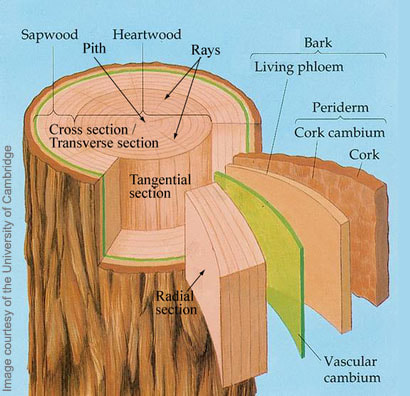 Figure 5
Cross section of a tree(16)
Figure 5
Cross section of a tree(16)
- Find the first primary lateral root. The soil line should be at this first root. Finding this root is important because you can’t plant at the right depth if you don’t know how deep the roots are in the root ball. In containerized stalk all you simply need to pull away some of the top soil. however for B&B you may need to cut the bur-lap back to be able to identify the location of the first root. For bare root stalk it is recommended to soak the roots in water for 3-6 hours prior to planting, and since there is no soil on bare root it is much easier to find the first (top) root(6).
- Dig your hole 1-2 times the width of the root ball (preferably) and as deep as the root ball, Remember first lateral root! For bare root since the root ball will be very small, its important to remove any surrounding vegetation around the new tree. this ensures that the vegetation wont out compete the new tree. 2-3 foot circle around the tree is a sufficient amount of space(6).
- Next if your tree stalk is in a container now is the time to remove it. Make sure to not yank on the trunk this can cause roots to detach from the main trunk, tap the sides of the container and this will free up the tree (2).
- When placing your tree in your newly dug hole, it is crucial to support it by the root ball DO NOT pick it up by the trunk. picking up your stalk especially B&B can damage the cambium do too its higher weight. The cambium is a very thin layer of growing tissue that produces new cells. They become either xylem, phloem or more cambium. Every growing season, a tree’s cambium adds a new layer of xylem to its trunk, producing a visible growth ring in most trees. The cambium is what makes the trunk, branches and roots grow larger in diameter. The xylem, or sapwood, comprises the youngest layers of wood. Its network of thick-walled cells brings water and nutrients up from the roots through tubes inside of the trunk to the leaves and other parts of the tree(13). refer to figure 5 for a visual example of cambium.
- After you have placed the tree in the hole, double check your depth. The root flares should be at or slightly (1 to 2 inches) above grade (6).
- For B&B before back filling remove all wire and twine holding the basket together, then peel back the burlap off the top of the root ball, note( you do not need to remove the burlap under the root ball it can stay put). the reason to remove the wire and string is again the same concept of strangling the tree. In this case leaving the wire basket and ties of any kind can potentially strangle the roots causing problems(10). for container grown trees after removing the tree your roots may be encircling. this is shown below in figure 6. Correcting the encircling roots at this stage can be easily corrected by pruning them using the box method. this is depicted below in figure 7.
- Back fill your soil and make sure to not bury the root collar, this will help prevent girdling roots, pack the soil down lightly to help stabilize the tree.
- Next water in the new tree, and mulch the new area. Mulch should be 2 inches deep but keep the mulch at least 4 inches away form the trunk(6).
below are two common myths still used today.
Newly planted BAB trees need to be staked or guy-wired” or When planting a tree you must dig the whole 2-3 times deeper and wider then the root ball.
Trees tend to be stake more often than needed, as many people believe the artificial support improves the strength of a tree. However, as a tree bends and twists over time do to wind or other loading events, the tree grows new layers of wood (called reaction wood) to provide compensate for this movement. an example would be as people use there muscles to workout they put on more muscle. this is a similar concept with reaction wood.
A tree should be staked if it has a poor root ball, perhaps it was damaged in transport. However, this means you must pay close attention when staking as to not forget materials on the tree as this can be highly damaging.
If installed incorrectly…
A tree should be staked if it has a poor root ball, perhaps it was damaged in transport. However, this means you must pay close attention when staking as to not forget materials on the tree as this can be highly damaging.
If installed incorrectly…
- Prolonged staking of a tree can lower the over size of the root flare. this can lead to reduced stability and be a sign of root problems
- Also if staking materials aren’t clearly marked they can be tripping hazard
- The decisions to stake should be made on a tree to tree basis
How this is damaging?
|
As the wire or rope gets tighter it begins to crush cambial tissue. The tree will not be able to move water or sugars throughout itself, this will cause the tree to decline and if not corrected the tree will die. to the right in figure 8 is improper staking as this was left on too long. The staking may have been done right at planting but the tree grew and filled the space that was left by the planter.
The proper way to stake the tree is to ensure there is plenty of space between the tree and the straps. The straps should be loose allowing the tree to move in the wind but tight enough that it wont sway too far and fall over. Correct staking will help from girdling the tree. when a tree is planted to deep,its encircling roots act as the "too tight" canvas as shown on the right and they slowly strangle the tree. |
summary
Why are we concerned with improper staking or planting to deep? The reason is that when a tree is affected by girdling roots or strangling wires, the tree is inhibited. Instead of the tree putting energy into growing, putting on new wood, or more leaves. The tree is instead using most of its energy to maintain itself. Since its regular function is being slowed down or blocked. The reason the trees die is because the natural functions of the tree require an unsustainable amount of energy.
References
1. Lerner, Joel M. Joel M. Lerner - Tree myths: So much of what you've been told is wrong. http://www.washingtonpost.com/wp-dyn/content/article/2010/02/04/AR2010020405042.html?noredirect=on. [Online] febuary 10, 2010.
2. TREE PLANTING FUNDAMENTALS. Bassuk, Roger Harris and Nina L. 19, Ithaca NY : Journal of Arboriculture , march 1993, Vol.
3. Mahler, Tristan. Tristan's Camera.
4. correct staking. [Online] https://www.google.com/search?q=proper+staking+of+a+tree&client=firefox-b-1&source=lnms&tbm=isch&sa=X&ved=0ahUKEwjOkIix5LHeAhUCc60KHZ64DokQ_AUIDigB&biw=1025&bih=491#imgrc=DbqaVR3O21xQfM:.
5. picture. [Online] https://www.google.com/search?q=balled+and+burlapped&client=firefox-b-1&source=lnms&tbm=isch&sa=X&ved=0ahUKEwiOiMy9jK_eAhUROK0KHWeFBaQQ_AUIDigB&biw=1025&bih=491#imgrc=arIbXRfBD6JojM:.
6. Impacts of Wire Basket Retention and Removal on Planting Time, Root-Ball Condition, and Early Growth of Acer platanoides and Gleditsia triacanthos var. inermis. Andrew Koeser, Richard Hauer, Jeff Edgar, and David Kleinhuizen. 43, Manitowoc, Wisconsin : Arboriculture & Urban Forestry , 2015, Vol. 1.
7. day, arbor. Tree Planting. arbor day. [Online] https://www.arborday.org/trees/tips/planting.cfm.
8. —. square prunning. [Online] http://csuhort.blogspot.com/2014/03/arbor-day-is-coming-tree-planting-101.html.
9. air pruining pot. [Online] https://www.google.com/search?q=container+grown+tree&client=firefox-b-1&tbm=isch&tbs=rimg:CarYE70F6Th3Ijhdq3wADMyC1m_1ntJ9uctTvzn9sMdPg5apQxdFu-oe2svS6Yfqej88gNLzamZkZjdL63sWnyI8TTyoSCV2rfAAMzILWEeh73JrbCg42KhIJb-e0n25y1O8RyyDeJofOzSgqEgnOf2wx0-DlqhHa2azD.
10. solid walled pot. [Online] https://www.google.com/search?q=container+grown+tree&client=firefox-b-1&tbm=isch&tbs=rimg:CarYE70F6Th3Ijhdq3wADMyC1m_1ntJ9uctTvzn9sMdPg5apQxdFu-oe2svS6Yfqej88gNLzamZkZjdL63sWnyI8TTyoSCV2rfAAMzILWEeh73JrbCg42KhIJb-e0n25y1O8RyyDeJofOzSgqEgnOf2wx0-DlqhHa2azD.
11. Effect of Eight Container Types and Root Pruning During Nursery Production on Root Architecture of Acer rubrum. Edward F. Gilman, Maria Paz, and Chris Harchick. 42, n/a : Arboriculture & Urban Forestry , 2016, Vol. 1.
12. Nursery Planting Depth, Mulch Application, and Root Pruning at Landscape Planting Affect Tree Health and Anchorage. Edward F. Gilman, Maria Paz, and Chris Harchick. 41, n/a : Arboriculture & Urban Forestry , 2015, Vol. 2.
13. Elvitch, Craig R. The overstory book. hiloloa : Permanent Agriculture resources, 2004.
14. Container Production Strategies Influence Root Ball Morphology . Paz, Edward F. Gilman and Maria. 40, oxahatchee, Florida : Arboriculture & Urban Forestry , 2014, Vol. 1.
15. https://www.google.com/search?q=bare+root+tree+planting+stock&client=firefox-b-1-ab&source=lnms&tbm=isch&sa=X&ved=0ahUKEwiq7ZamifbeAhUL5awKHX9UBL0Q_AUIDygC&biw=1025&bih=491#imgrc=1ulvwb3IGFQdtM:
16. https://www.google.com/search?q=tree+cambium&client=firefox-b-1&source=lnms&tbm=isch&sa=X&ved=0ahUKEwjPrKrRp_jeAhUM16wKHZZaDB0Q_AUIDygC&biw=1025&bih=491#imgrc=C8vEV5dPPoxnXM:
17. https://www.google.com/search?client=firefox-b-1&biw=1025&bih=491&tbm=isch&sa=1&ei=yDH_W_vpEoagtQWcya2QCA&q=encircling+roots+in+a+pot&oq=encircling+roots+in+a+pot&gs_l=img.3...22415.23594..23789...0.0..0.88.697.9......1....1..gws-wiz-img.hIp0VCmT2CY#imgrc=Sy9-ZENhqRLeOM:

